
This parent guide supports parents in helping their child at home with the 6th grade Math content.
- Subject:
- Mathematics
- Material Type:
- Reference Material
- Author:
- Kelly Rawlston
- Letoria Lewis
- Date Added:
- 01/05/2022

This parent guide supports parents in helping their child at home with the 6th grade Math content.

This resource accompanies our Rethink 6th Grade Math course. It includes ideas for use, ways to support exceptional children, ways to extend learning, digital resources and tools, tips for supporting English Language Learners and students with visual and hearing impairments. There are also ideas for offline learning.

This word problem requires students to use fractions to solve it.

One common mistake students make when dividing fractions using visuals is the confusion between remainder and the fractional part of a mixed number answer.
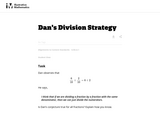
The purpose of this task is to help students explore the meaning of fraction division and to connect it to what they know about whole-number division.

REMIX - Added accessibility enhancements.Students explore methods of dividing a fraction by a unit fraction.Key ConceptsIn this lesson and in Lesson 5, students explore dividing a fraction by a fraction.In this lesson, we focus on the case in which the divisor is a unit fraction. Understanding this case makes it easier to see why we can divide by a fraction by multiplying by its reciprocal. For example, finding 34÷15 means finding the number of fifths in 34. In this lesson, students will see that this is 34 × 5
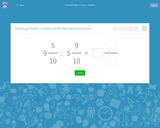
For this activity, students solve equations by dividing mixed numbers with like denominators.
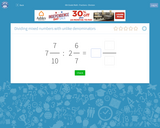
For this activity, students solve equations by dividing mixed numbers with unlike denominators.

This short video and interactive assessment activity is designed to teach fifth graders about dividing whole numbers by mixed numbers.
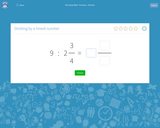
For this activity, students divide by a mixed number.

Students will review their learning on long division, decimal division, and fraction division. Students will be able to choose what they complete for each section which gives them some variability in their learning. Students are also able to choose between taking a typical test or completing a "more fun" activity such as creating a poster or videoing themself teaching a couple problems. This resource was developed as part of a professional learning opportunity funded by the NCDPI Digital Learning Initiative Planning Grant.
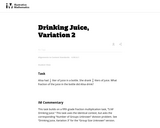
This task builds on a fifth grade fraction multiplication task and uses the identical context, but asks the corresponding ŇNumber of Groups UnknownÓ division problem.

This task builds on a fifth grade fraction multiplication task and uses the identical context, but asks the corresponding ŇNumber of Groups UnknownÓ division problem.

Students will complete their understanding of the four operations as they study division of whole numbers, division by a fraction and operations on multi-digit decimals. T

Grade 6 Module 2: Arithmetic Operations Including Division of Fractions. Contains 19 Lessons.
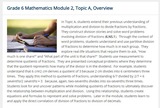
Through the context of word problems, students understand and use partitive division of fractions to determine how much is in each group. They explore real-life situations that require them to ask, “How much is one share?” and “What part of the unit is that share?”

These two fraction division tasks use the same context and ask ŇHow much in one group?Ó but require students to divide the fractions in the opposite order. Students struggle to understand which order one should divide in a fraction division context, and these two tasks give them an opportunity to think carefully about the meaning of fraction division.
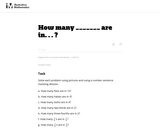
These problems are meant to be a progression which require more sophisticated understandings of the meaning of fractions as students progress through them.
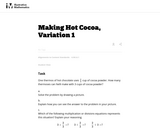
This is the first of two fraction division tasks that use similar contexts to highlight the difference between the ŇNumber of Groups UnknownÓ a.k.a. ŇHow many groups?Ó (Variation 1) and ŇGroup Size UnknownÓ a.k.a. ŇHow many in each group?Ó (Variation 2) division problems.

This is the second of two fraction division tasks that use similar contexts to highlight the difference between the ŇNumber of Groups UnknownÓ a.k.a. ŇHow many groups?Ó (Variation 1) and ŇGroup Size UnknownÓ a.k.a. ŇHow many in each group?Ó (Variation 2) division problems.